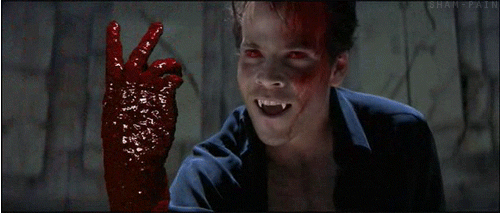Blade (1998)—Marvel’s Sleeper Hit

In 1995, Marvel Studios was filing for bankruptcy and sold some of their most iconic characters to other companies, including Sony and Universal. Eventually, New World Pictures bought the rights to Marvel Comics. In a collaboration with New Line Cinema, Marvel released Blade (1998) into theaters.

The film opens up with a profusely bleeding woman being rushed into a hospital. It’s revealed that she’s been bitten by a vampire and the doctors perform a C-section to save her baby, however, she succumbs to her wounds. In the present day, Blade (played by Wesley Snipes) crashes a vampire rave in search for a vampire named Quinn (played by Donal Logue). He lights Quinn on fire and leaves the scene as police arrive. Quinn is taken into a hospital and bites one of the doctors, Dr. Karen Johnson (played by N’Busche Wright). Blade soon arrives and knocks out Quinn and reluctantly saves Dr. Johnson by taking her back to his base. There, she meets Abraham Whistler (played by Kris Kristofferson), a human vampire hunter and Blade’s surrogate father. Whistler explains the world of vampires to Dr. Johnson, which inspires her to create a cure for vampirism. Meanwhile, a young, upstart vampire known as Deacon Frost (played by Stephen Dorff) plans to awaken an ancient blood god known as La Magra to enslave the human race.

Blade (1998) took many creative liberties from its source material. Originally in the comics, Blade was a very talkative and colorful character. However, in the film, he is quiet and austere. Additionally, many other characters from the comics that made it into the films, such as Deacon Frost, were also updated to fit in with a 90’s audience. At the time, comic book films were treated as kid’s entertainment. With films such as 1997’s Batman and Robin certainly didn’t help break that mold. However, with Blade (1998)’s serious tone and kickass action, it gained a cult following and made people realize that comic book films could be badass. This would lead to other comic book films, such as X-Men (2000) and Spider-Man (2002) being made. Despite many people looking towards Deadpool as the first R-rated superhero movie, Blade (1998) beat it to the chase by almost 20 years.

Where the film shines is in its action. Wesley Snipes is a legit martial artist and possesses a 5th degree black belt in Shotokan Karate and 2nd degree black belt in Hapkido. He could do the long takes without any worries about whether or not he looks like he knows what he’s doing. Every technique he uses is crisp and shows the beauty of comic book films when you cast a trained martial artist. The film was Stephen Norrington’s second film he directed and he did his best to capture the feel of a comic book. Every shot has style and flair to it. Another aspect of the film I enjoyed was that it is not a standard action movie and actually broke several tropes seen in action movies. For example, Dr. Karen Johnson is never presented as a love interest for Blade. She helps him combat Deacon Frost and creates a weaponized cure for Blade to use against his foes. While Blade does initially save her several times, in the end, she manages to fight on her own against Frost’s men in the third act.

Perhaps the weakest elements of the film are its special effects and on a lesser note, its side villains. While the use of CGI was still a fairly new concept at the time, there have been excellent use of CGI, such as the dinosaurs in Jurassic Park (1993) and several scenes with the T-1000 in Terminator 2: Judgement Day (1991). However, those films knew what they were capable of accomplishing with CGI and still utilized it in conjunction with practical effects.

Blade (1998), on the other hand, tried to be a bit too ambitious for its own good; the CGI in the final fight was ropey and jagged. To make matters worse, the fight in the final cut was actually better than the original cut, where Frost was going to turn into this giant swirling mass of blood. The original fight was poorly received by test audiences, and the production crew reshot the final fight. In my opinion, the film’s best use of special effects was the train sequence. In production, there was no train present, and everything was created using clever lighting, wind effects, and CGI. This proves that while technology was evolving for movies, there were still some things that could not be accomplished purely with CGI at the time.

Overall, while Blade (1998) is a film that has a couple of problems with its use of CGI and the dated 90’s feel, it helped make comic book movies as mainstream and big as they are today. Blade (1998) proves that comic book films can be stylish, cool, and totally badass when taken seriously.









